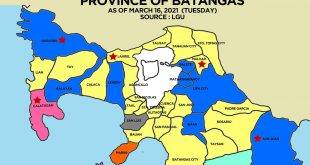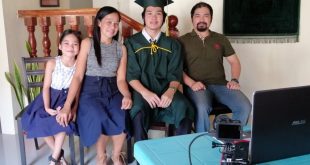Visit the Mabini, Batangas page for all information on Mabini.
HISTORY OF MABINI, BATANGAS
Legend states that the first Malay settlers to inhabit the vast fertile land bordering the two bodies of water now known as the Batangas Bay and the Balayan Bay, first found anchor along the shores of the land protruding down Southwest ward known geographically as the Calumpan Peninsula.
These Malay settlers found the land fertile and agriculturally appropriate and the sea rich in marine resources. They established their settlement in this once vast unknown land. As more Malay settlers arrived from distant lands, more settlements were founded until even the upland regions of the peninsula were settled.
The inhabitants had their own form of village government. They were ruled by a headman, a datu, or a sultan, in case of big encampments. Malay civilization began to take roots. Rapid increase of population brought about the settlements of all the neighboring regions, that it did not take long before eastward, northward, and southward of these known regions were inhabited to comprised later on the whole province of Kumintang, better known later as Batangas.
It was also mentioned among the folklore of this community that a Chinese explorer and geographer whose name could no longer be recalled, first landed on the shores of this peninsula in one of his trips to the island of Mai which is now known as Mindoro. Chinese, Indonesians and other races found haven for their trade along the shores of this peninsula during the pre-spanish era.
During the Spanish times, a certain galleon of the Spanish government, plying between this country and Mexico, was attacked, plundered and sunk by the Moro pirates riding in glittering vintas along the shores of this peninsula. It can also be said in passing that the Malay settlers were subjected to the uttermost cruelty and vandalism done by the Moro pirates who wantonly attacked the villagers along the coasts.
These Moro forages caused hardships and other difficulties to the inhabitants, resulting in their formation of stronger measures to counteract the Moro depredations. This menace to the lives and properties during the pre-spanish era continued during the Spanish times, and for purposes of administrative expediency, there were created political subdivisions-the insular territories to provinces, the provinces to municipalities or “pueblos”, the “pueblos” or municipalities to barrios and lastly to sitio.
It came to pass then that the Calumpan Peninsula was made a part and parcel of the pueblo or municipality of Bauan, in the province of Kumintang, now Batangas .The same peninsula territory of Bauan was subdivided into barrios, namely: Mainaga, Pulong-Niogan, Pulong-Balibaguhan, Anilao, Solo, Pulong-Anahao, Bagalangit, Nag-Iba, Malimatoc, Saguing and Talaga.
For more than three hundred years, while the Archipelago was under Spanish domination, this peninsula remained a part of the “pueblo” of Bauan and even in the early part of the American occupation. The people of this peninsula, like other people of other regions, suffered untold hardships under the Spanish rule. The yoke of the Spanish tyranny was thrown off after the gallant uprising of 1896. The revolution emancipated the people from the tyrants of Spain.
In that revolutions, the people of this peninsula were not found wanting in courage, as the cream of the youths of the community joined the revolutionary forces, and even during the fight against the American forces they did not withdraw their support of the insurgents’ cause. Foremost of the heroic young men was Don Francisco Castillo, known as Apian Kiko, who led the fight for freedom in this peninsula. In this glorious revolution, many valiant heroes, hailing from the different places of the peninsula, offered their lives to the altar of the motherland.
The present generation of this community failed not to reciprocate the great deeds of those who fell in the dark of the night, when under popular subscriptions, headed by no less than Dr. Laureano Castillo, son of the famed leader, Kapitan Kiko and the then Municipal President Julian Bautista, Chairman and Vice-Chairman, respectively, of the drive, they honor to the men who died for their country with a monument constructed in front of the old presidencia building.
Although it was built primarily to erect the image of the Great Sublime Paralytic, Apolinario Mabini, it now also serves as a repository for the bones of the thirteen martyrs of this place who died in the memorable battle of Mahabang-Dahilig, during the Philippine–American Warnamely: Tirso Sumadsad, Juan del Espiritu Santo, Ramon Ilagan, Julian Matulin, Bernardo de los Reyes, Enrique Castillo, Zacarias Castillo, Francisco de Claro, Moises Maramot, Nicolas Adalia, Pantaleon Panopio, Serapio Aspi and Gavino Garcia upon the advent of the American rule, the same peninsular territory of Bauan remained with the mother municipality, until, after great efforts had been exerted by the proponents of establishing a new municipality, independent of the town of Bauan, fortunately for this peninsula, such men as Don Regino Marasigan, then Municipal President of Bauan, and such illustrious sons of this community, namely: Don Francisco Castillo whose gallantry had been mentioned above; Ignacio Leynes, who later on became the father-in-law of the famed revolutionary leader, Tomas Castillo, Indalecio Calangi, Anselmo Sandoval, Marcelino Castillo, Epifanio Abrigonda, Andres Castillo, Nicomedes Guia, Venancio Castillo, Esteban Castillo, Juan Dolor, Pedro Manalo, Bartolome Jusi, Agaton Axalan and many many others that cannot be mentioned for lack of space, left no stones unturned, and in the end, found the good graces of the then Governor General Leonard Wood and the great leader of our country, then Senate President Manuel L. Quezon, resulting in the declaration of the new municipality, comprising the eleven (11) barrios of the Calumpan Peninsula and the whole of the Maricaban Island, as an independent municipality, with the name of MABINI, derived from the great name of that Sublime Paralytic, Brain of the Revolution and Premier Adviser to the president of the erstwhile Philippine Republic, Gat Apolinario Mabini.
The new-born municipality of Mabini province of Batangas, was inaugurated on January 1, 1918, with Captain Francisco Castillo, known as the founder of the town, as the first appointive Municipal President. With him to form the local officials of the newly inaugurated town were: Marcelino Castillo as Municipal Vice-President; Esteban de Joya as Municipal Secretary; Jose Generoso as Municipal Treasurer and Tomas Cuevas as Justice of the Peace. Appointed Municipal Councilors were Tomas Castillo, Pedro Manalo, Epifanio Abrigonda, Valeriano de Chavez, Tranquilino Buenviaje, Nicomedes Guia, Fermin Buenviaje and Juan Castillo. To form the local police force, Esteban Castillo was appointed Acting Chief of Police, and Messrs. Julian Bautista, Nicomedes Aguila, Policarpio Axalan, Marcos Panopio, Marcelo Reyes and Nazario Manalo, as policemen.
Online Source: http://en.wikipedia.org/wiki/Mabini,_Batangas
Last Updated: September 12, 2013
 WOWBatangas.com Your Source of Great News and Stories from the Province of Batangas, Philippines
WOWBatangas.com Your Source of Great News and Stories from the Province of Batangas, Philippines



